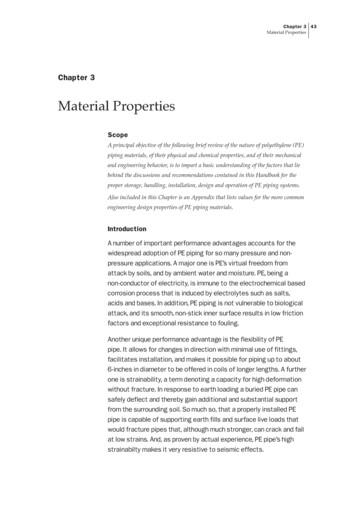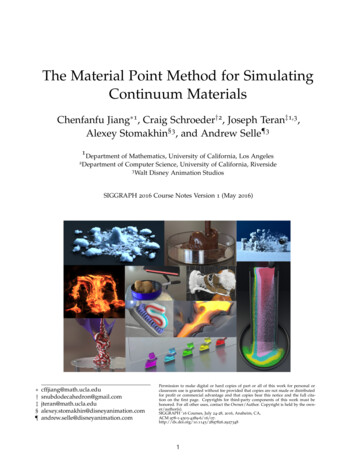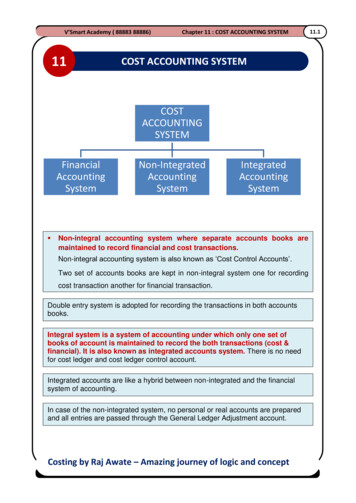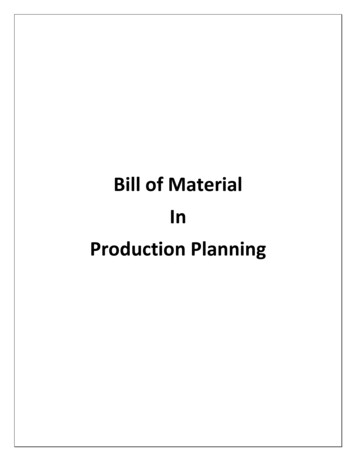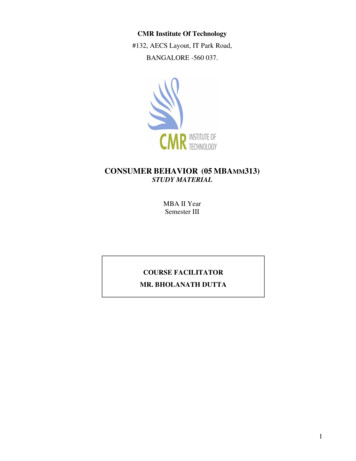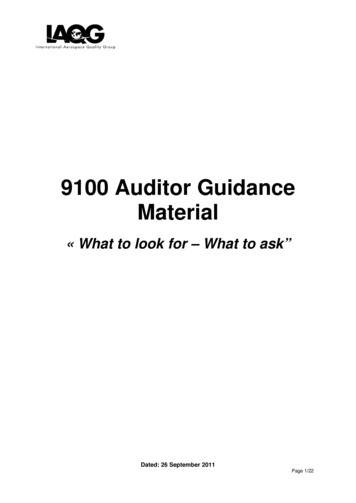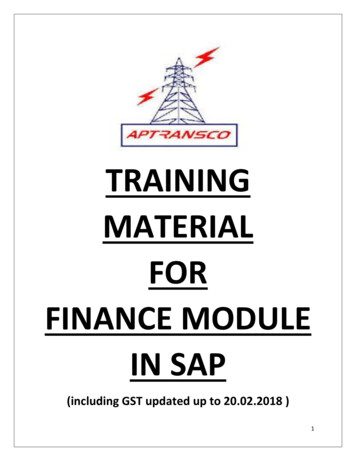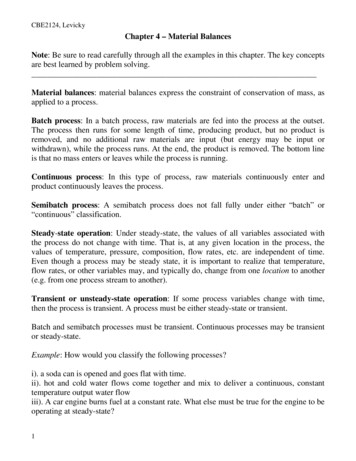
Transcription
CBE2124, LevickyChapter 4 – Material BalancesNote: Be sure to read carefully through all the examples in this chapter. The key conceptsare best learned by problem solving.Material balances: material balances express the constraint of conservation of mass, asapplied to a process.Batch process: In a batch process, raw materials are fed into the process at the outset.The process then runs for some length of time, producing product, but no product isremoved, and no additional raw materials are input (but energy may be input orwithdrawn), while the process runs. At the end, the product is removed. The bottom lineis that no mass enters or leaves while the process is running.Continuous process: In this type of process, raw materials continuously enter andproduct continuously leaves the process.Semibatch process: A semibatch process does not fall fully under either “batch” or“continuous” classification.Steady-state operation: Under steady-state, the values of all variables associated withthe process do not change with time. That is, at any given location in the process, thevalues of temperature, pressure, composition, flow rates, etc. are independent of time.Even though a process may be steady state, it is important to realize that temperature,flow rates, or other variables may, and typically do, change from one location to another(e.g. from one process stream to another).Transient or unsteady-state operation: If some process variables change with time,then the process is transient. A process must be either steady-state or transient.Batch and semibatch processes must be transient. Continuous processes may be transientor steady-state.Example: How would you classify the following processes?i). a soda can is opened and goes flat with time.ii). hot and cold water flows come together and mix to deliver a continuous, constanttemperature output water flowiii). A car engine burns fuel at a constant rate. What else must be true for the engine to beoperating at steady-state?1
CBE2124, Levickyiv). In example (iii) above, how would you classify the changes in the gas tank? Are thesechanges indicative of a batch, continuous, or semibatch type operation? Transient orsteady-state?v). Water freezes in a sealed bottle.General Material Balance Equationinput generation – output – consumption accumulation(0)Input: enters through system boundariesGeneration: is produced within the systemOutput: exits through system boundariesConsumption: is used up within the systemAccumulation: is built up within the systemExample: How would the material balance look for mass of species A, mass of species B,and mass of species C, for the below process?What would the A, B, and C balances be if the operation were steady state?What would the balance be for total mass, A B C, at steady state?2
CBE2124, LevickyDifferential balances: The terms in a differential material balance are expressed asrates; that is, rate of input (e.g. moles/s, kg/s), rate of generation, rate of output, and rateof accumulation. Differential balances are applied to continuous processes.Integral balances: These usually apply to batch processes. The terms in a batch materialbalance are expressed as amounts (molar or mass). Input is the amount placed into thesystem initially at the start of the process. The process is then sealed while thereaction/transformation of the input materials takes place. At the end, the process isopened and the contents are removed: output is the amount removed at this stage,including products and any unconverted reactants. Generation/consumption are theamounts produced/consumed during the time between the start and the end of the process.Accumulation is the amount left behind in the process (this is zero if all materials areremoved).3
CBE2124, LevickyExample 4.2-2 (Material balances on a continuous distillation process)One thousand kilograms per hour of a mixture of benzene (B) and toluene (T) containing50% benzene by mass is separated by distillation into two fractions. The mass flow rateof benzene in the top stream is 450 kg B/h and that of toluene in the bottom stream is 475kg T/h. The operation is at steady state. What are the unknown benzene and toluene flowrates in the output streams?4
CBE2124, LevickyExample 4.2-3 (Material balances on a batch mixing process)Two methanol-water mixtures are contained in separate flasks. The first mixture is 40.0wt % methanol, and the second is 70.0 wt % methanol. If 200 g of the first mixture iscombined with 150 g of the second, what will be the mass and composition of theresulting mixture?5
CBE2124, LevickyExample 4.2-4 (Material balances on a semibatch process)Air is bubbled through a container of liquid hexane at a rate of 0.100 kmol/min. It thenleaves the container, such that the output gas contains 10.0 mole % hexane vapor.Assume that air is insoluble in liquid hexane. What is the time required to vaporize 10.0m3 of the hexane?6
CBE2124, LevickyFlowchartsFlowcharts are used to summarize the layout of a process as well as to indicate knowninformation about the state of the process streams. Such information may include flowrates, compositions, pressures, temperatures, and energy inputs. Flowcharts are also usedto indicate all unknown variables of interest. Being able to draw and label a flowchart,based on a textual description of a problem, is EXTREMELY important in learning toproperly set up material and energy balance problems.Example 4.3-1 (Flowchart of an air humidification and oxygenation process)Three streams are fed into an evaporation chamber to produce a single gas output streamcontaining 1.5 mole % water. The three input streams are:1). water at 20.0 cm3/min2). Air (21 mole % O2, 79 mole % N2)3). Pure oxygen, at a molar flow rate that is 1/5 that of the air stream.Draw and label a flowchart for this process.7
CBE2124, Levicky8
CBE2124, LevickyFlowchart scaling: the flowrates or material amounts on a flowchart can be scaled up ordown without violating material balance constraints, as long as all flowrates or materialamounts are scaled by the same factor.Example: Given the following, steady-state, balanced mixing process,How would the above diagram change if we scale it to a 10 kg/min flowrate of the pure Astream? (1 kg 2.204 lbm)Degree of Freedom AnalysisRecall: If you have N unknown variables (such as flowrates, compositions) whose valueyou need to solve for, you will need exactly N independent equations relating thesevariables (“number of independent equations number of unknowns”).Independent equations: equations are independent if none of them can be derived fromthe others. For example, not one of the set of equations can be obtained by adding orsubtracting multiples of the others.Example: Try to obtain the numerical vale of x and y in the following examples. If it isnot possible, why not?(i)x y 1(ii)9x y 1; x – y 2
CBE2124, Levicky(iii)x y 1; x – y 2; y 3(iv)x y 1; 2x 2y 2Degrees of freedom (symbol ndf):ndf nunknowns – nindep eqns(1)If, for a given problem,ndf 0: A numerical value for each unknown can be obtained. The problem is solvable.ndf 0: The problem is underspecified (underdetermined). There is not enoughinformation (i.e. not enough independent equations) to provide a solution.ndf 0: The problem is overspecified (overdetermined). The problem is mathematicallyand possibly physically inconsistent.10
CBE2124, LevickyGeneral Procedure for Solving Material Balance Calculations1). Choose a basis of calculation.2). Draw and completely label the flowchart. The flowchart is fully labeled if thecomposition and flowrate (or amount) of each process stream can be expressed in termsof the labeled quantities. For each stream, usually you will either label (1) the total massflow together with the mass fractions of all the stream components, (2) the total molarflow and mole fractions of all stream components, or (3) the mass or molar flows for eachof the stream components. If you are starting from mixed mass and mole units for astream, convert all quantities to either the mass or the molar basis first.Example: these are three possible representations of the same stream:3). Express the result (unknown) of interest in terms of the quantities on the flowchart.4). Perform a degree of freedom analysis. Add up the number of unknown variablesyou’ll need to determine. Then add up the number of independent equations relating theunknown variables. Independent equations can come in different flavors - you need toaccount for all of them to do the degree of freedom analysis properly. The equations mayinclude material balances, an energy balance (to be discussed in later chapters),information from the problem statement not already listed on the flowchart, physicalproperties and laws (e.g. ideal gas equation to relate P, V and T; tables of density tointerconvert mass and volume), physical constraints (such as the sum of all mass or allmolar fractions must add up to 1) and, for a reactive process, stoichiometric constraintsderived from the chemical reactions taking place (to be discussed later). If the number ofdegrees of freedom 0, the problem is solvable.11
CBE2124, LevickyNote: For a nonreactive process, the number of independent material balances cannotexceed the number of chemical species in the process.5). Write down the equations you will solve. Try to write them in an order that willsimplify the calculations. For example, write equations with only one unknown first, asthese can be solved right away and, once solved, will eliminate an unknown fromsubsequent calculations.6). Solve the equations. Scale the process if the scale used for the calculations wasdifferent from that needed.Example 4.3-5 (Material balances on a distillation column)A liquid mixture containing 45.0 % benzene (B) and 55.0 % toluene (T) by mass is fed toa distillation column. The overhead product stream contains 95.0 mole % B. The bottomproduct stream contains 8.0% of the benzene fed to the column. The feed streamflowrate is 2000 L/h and the specific gravity of the feed mixture is 0.872.What is the mass flowrate of the overhead product stream, and what are the mass flowrateand composition, in mass fractions, of the bottom product stream? Follow the aboveoutlined methodology to arrive at the solution. Note that the column operates at steadystate.12
CBE2124, Levicky13
CBE2124, LevickyMultiple Unit ProcessesWhen an interconnected network of process units is involved in a material balancecalculation, one typically has to make balances on individual process units, combinationsof several units, as well as the overall, multiple unit system in order to arrive at thesolution. Balances that are taken on the overall system, which do not involve any internalprocess streams, are referred to as overall balances. For each subsystem (e.g. a singleunit, a combination of units), as well as the total process, a degree of freedom analysiswill apply. You may need to solve the balances on one subsystem first in order todetermine values of variables needed to solve balances on another.Recycle: When a part of a process stream is fed back into an earlier stage of the process,the stream is said to be “recycled.” Recycle is often used to increase the rates ofconversion of a reactant. By passing a reactant molecule through the process severaltimes, its chances to react and convert to product are increased. Other reasons to recyclepart of a stream include recovery of valuable materials, such as catalysts, improvedtemperature control over a process, and decreased waste of working (carrier) fluid.Bypass: When a part of a process stream is fed forward into a later stage of the process,the stream is being “bypassed.” Bypass is useful, for example, for decreasing the extentof conversion of input materials or for providing improved control over streamtemperatures.Example 4.5-2 (An evaporative crystallization process)The process is steady-state. 4500 kg/h of a solution that is 1/3 K2CrO4 by mass is joinedby a recycle stream containing 36.4 % K2CrO4, and the combined stream is fed into anevaporator. The concentrated stream leaving the evaporator contains 49.4% K2CrO4, andis in turn fed into a crystallizer in which it is cooled. The cooling causes crystals ofK2CrO4 to precipitate. The crystals are then filtered out of the solution. The “filter cake”consists of K2CrO4 crystals and a solution that contains 36.4 % K2CrO4 by mass, such14
CBE2124, Levickythat the crystals account for 95 % of the total mass of the filter cake. The “filtrate”solution that passes through the filter also contains 36.4 % K2CrO4, and is recycled.Use (K) to denote K2CrO4, and (W) to denote water.What are the (i) mass rate of evaporation, (ii) the mass rate of production of K2CrO4crystals, (iii) the mass feed rates that the evaporator and the crystallizer must handle, and(iv) the recycle ratio? The recycle ratio (mass of recycle)/(mass of fresh feed).What would be the mass production rate of the crystals if the filtrate was discardedinstead of recycled?15
CBE2124, Levicky16
CBE2124, LevickyMaterial Balances on Processes with Chemical ReactionsDefinitions and Terminology.Chemical reaction equations. Chemical reactions do not create, destroy, or convertatoms. Therefore, the quantities of each type of atom on the two sides of a chemicalreaction equation MUST be the same. In other words, chemical reaction equations mustbe stoichiometrically balanced.Example:Is CH4 2O2 CO2 2H2O stoichiometrically balanced?Is 6HF 2SiO2 H2SiF6 2H2O stoichiometrically balanced?Stoichiometric coefficient of a reacting species is the numeric prefactor of the speciesin the chemical reaction equation. What are the stoichiometric coefficients in the above(correctly balanced) equation involving combustion of methane?Stoichiometric ratio is the ratio of the stoichiometric coefficients of two speciesinvolved in a chemical reaction. This r
properly set up material and energy balance problems. Example 4.3-1 (Flowchart of an air humidification and oxygenation process) Three streams are fed into an evaporation chamber to produce a single gas output stream containing 1.5 mole % water. The three input streams are: 1). water at 20.0 cm 3/min 2). Air (21 mole % O 2, 79 mole % N 2) 3). Pure oxygen, at a molar flow rate that is 1/5 that .


